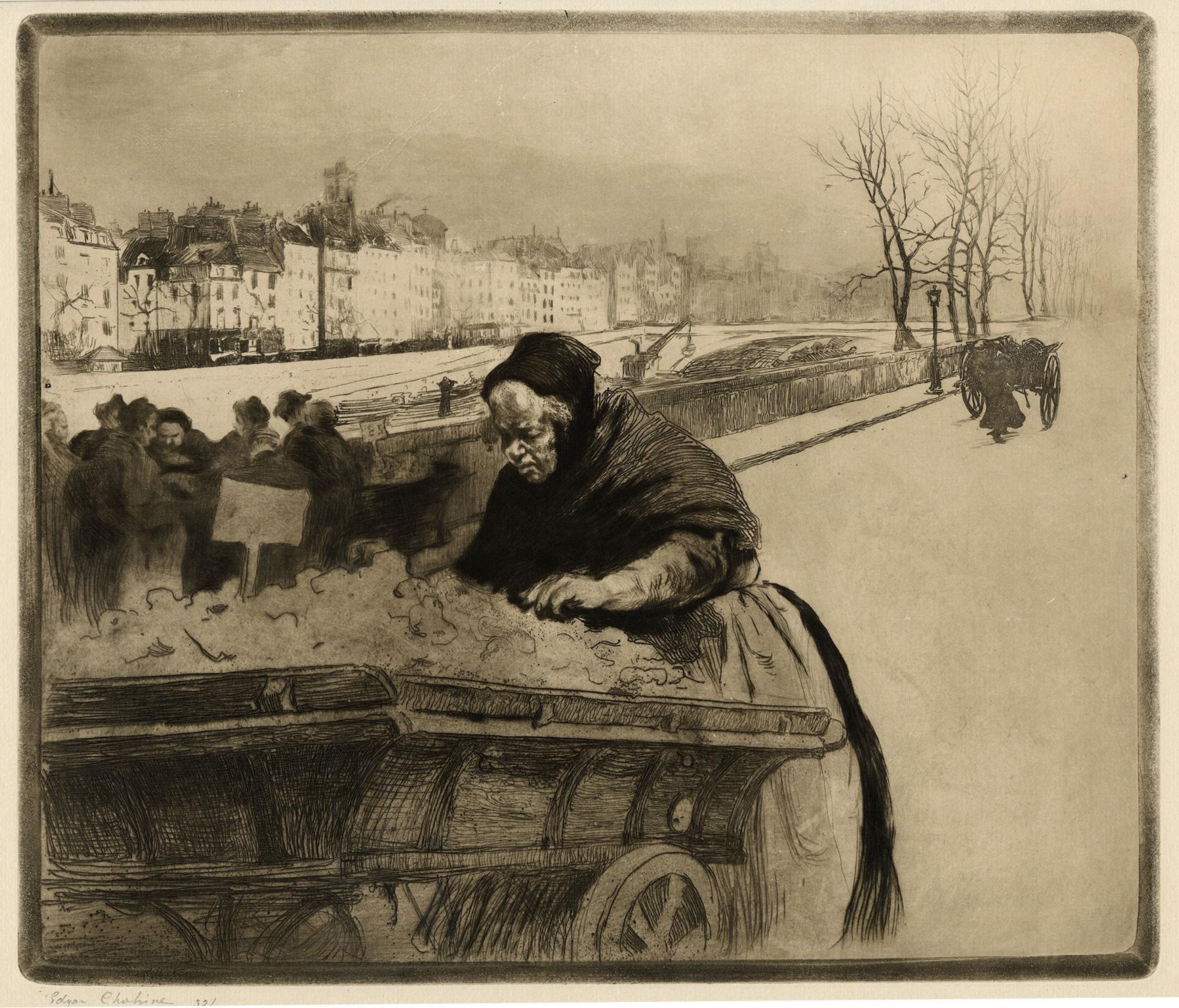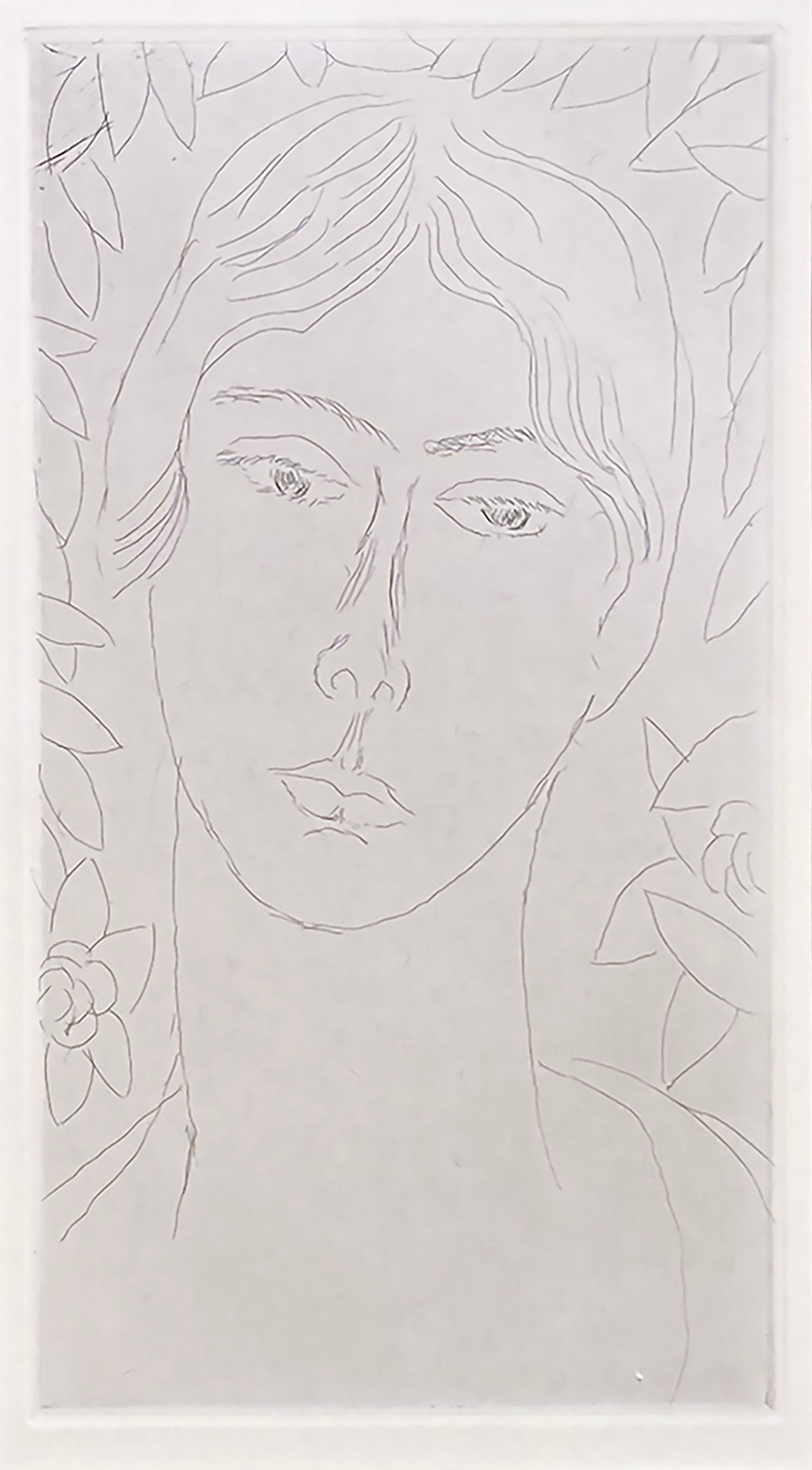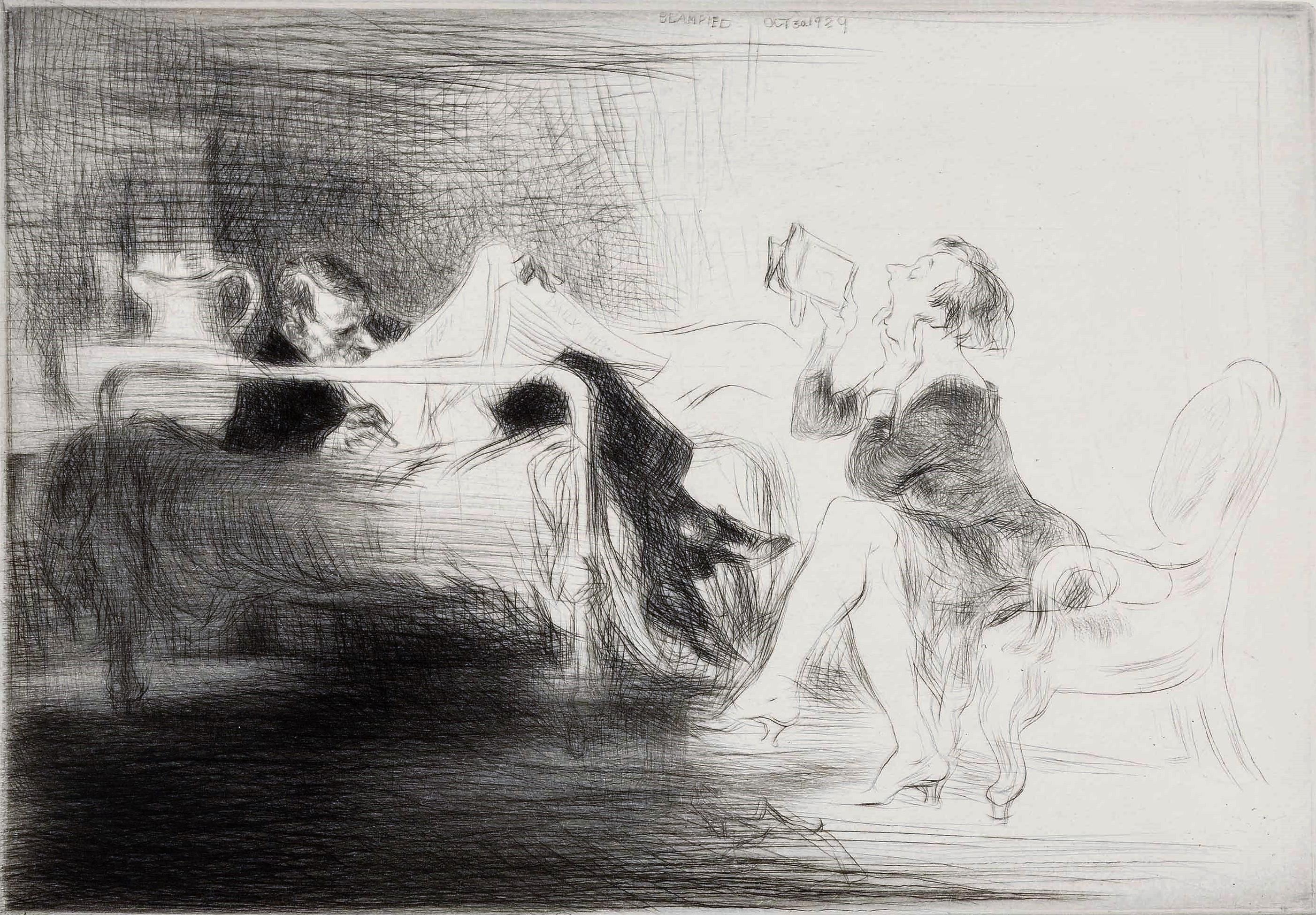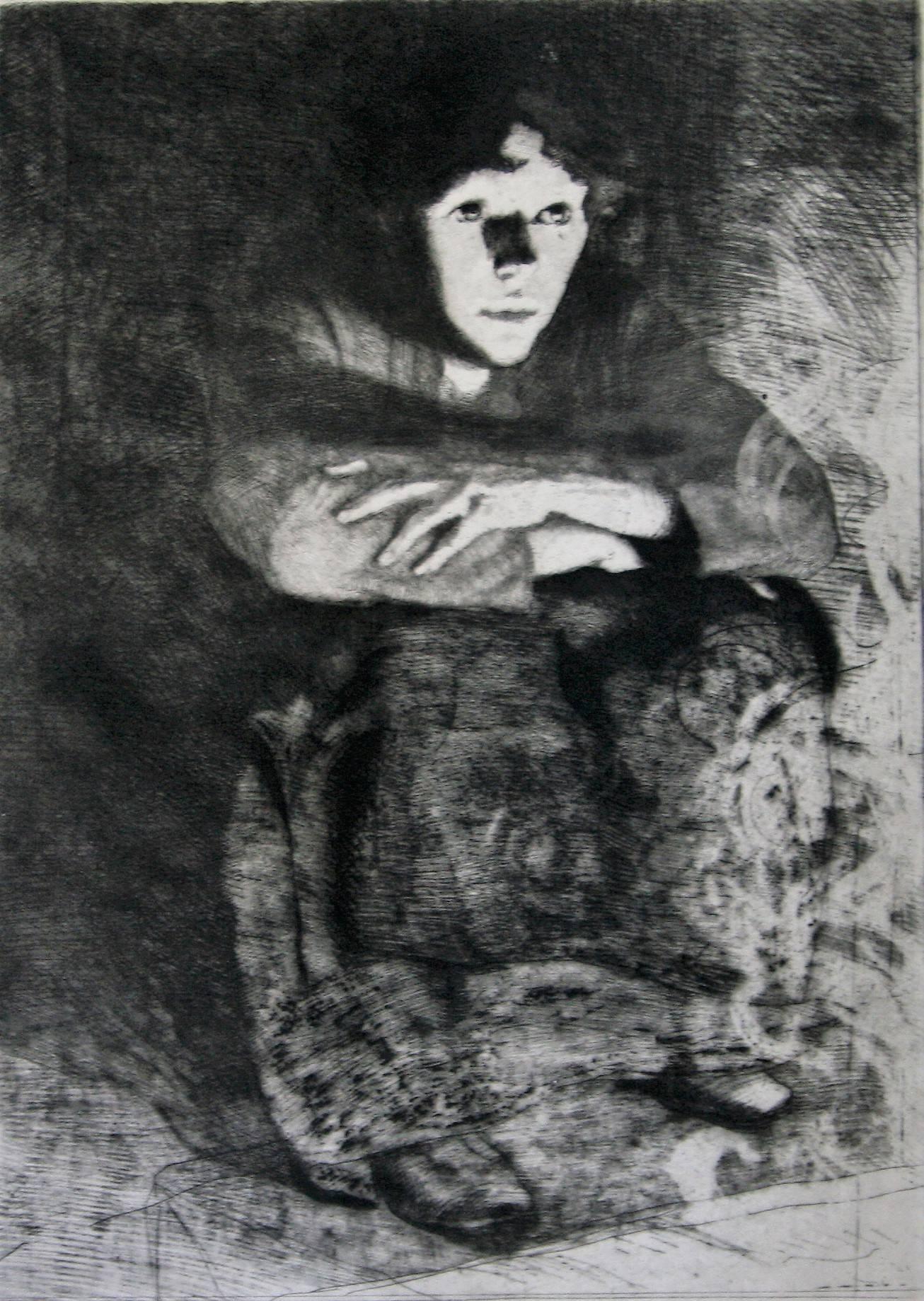Items Similar to Promenade dans la Neige - Etching by J. Tissot - 1880
Want more images or videos?
Request additional images or videos from the seller
1 of 9
James TissotPromenade dans la Neige - Etching by J. Tissot - 18801880
1880
About the Item
Beautiful print on verge crème, 2° state on 3, with letters printed in red. Stamp “Lugt 1545”.
Little crack and fold on lower left margin of the sheet.
Some small traces of oxidation.
Full margins.
Ref. Wentworth 48.
- Creator:James Tissot (1836-1902, French)
- Creation Year:1880
- Dimensions:Height: 22.29 in (56.6 cm)Width: 10.52 in (26.7 cm)Depth: 0.04 in (1 mm)
- Medium:
- Movement & Style:
- Period:
- Condition:Insurance may be requested by customers as additional service, contact us for more information.
- Gallery Location:Roma, IT
- Reference Number:
James Tissot
James Jacques Joseph Tissot (October 15, 1836 - August 8, 1902) was a French painter. Tissot was born at Nantes. He studied at the Êcole des Beaux-Arts in Paris under Ingres, Flandrin and Lamothe, and exhibited in the Paris Salon for the first time at the age of twenty-three. In 1855 Tissot moved to Paris where he studied under Jules-Élie Delaunay, Louis Lamothe and Hippolyte Flandrin. Lamothe, who had been a pupil of Ingres, introduced him to Edgar Degas. The two men became close friends. Another friendship formed at this time was with James McNeill Whistler. Two portraits, including one of Tissot's mother, were among the artist's first exhibits at the Paris Salon in 1859. In 1861 he showed The Meeting of Faust and Marguerite, which was purchased by the state for the Luxembourg Gallery. His first characteristic period made him a painter of the charms of women. Demi-mondaine would be more accurate as a description of the series of studies that he called La Femme à Paris. Tissot fought in the Franco-Prussian War, and, falling under suspicion as a Communard, left Paris for London. Here he studied etching with Sir Seymour Haden, drew caricatures for Vanity Fair, and painted portraits as well as genre subjects. Sometime in the 1870s Tissot met a divorcée, Mrs. Kathleen Newton, who became his muse and the model for many of his paintings.
About the Seller
4.9
Platinum Seller
These expertly vetted sellers are 1stDibs' most experienced sellers and are rated highest by our customers.
1stDibs seller since 2017
6,767 sales on 1stDibs
Typical response time: 2 hours
- ShippingRetrieving quote...Ships From: Monaco, Monaco
- Return PolicyA return for this item may be initiated within 14 days of delivery.
More From This SellerView All
- Dame Romaine - Etching and Drypoint by Lèon Gaucherel - 1862By Léon GaucherelLocated in Roma, ITImage dimensions: 10.5 x 6.5 cm. Dame Romaine is an original modern artwork realized by the French artist Léon Gaucherel (1816-1886) in 1862. Original...Category
1860s Figurative Prints
MaterialsEtching, Drypoint
- Portrait of Adolph Menzel - Etching by Giovanni Boldini - 1897By Giovanni BoldiniLocated in Roma, ITPortrait of Adolph Menzel is a magnificent drypoint realized by Giovanni Boldini in 1897. Reference: Buzzoni / M. Toffanello, Museo Giovanni Boldini, G...Category
1890s Modern Portrait Prints
MaterialsEtching, Drypoint
- Trajan - Drypoint Etching attr. to Salvador Dalì - 1973By Salvador DalíLocated in Roma, ITTrajan is an original contemporary artwork realized in 1973. Black and white drypoin etching. Hand signed on the lower margin. Numbered on the lower left. Edition of 216/261. Ref...Category
1970s Surrealist Figurative Prints
MaterialsDrypoint, Etching
- Embarking - Etching and Dry point - 19th CenturyLocated in Roma, ITEmbarking is an original Etching aquatint and drypoint realized by an anonymous artist in the 19th Century. Fine impression on laid paper. Very good condition.Category
19th Century Modern Figurative Prints
MaterialsEtching, Drypoint
- The Race - Original Etching by Robert Naly - Mid 20th CenturyBy Robert NalyLocated in Roma, ITThe Race is an Original Etching and Drypoint realized by Robert Naly (1900-1984). Good condition on a yellowed paper . Hand-signed by the artist on the lower right corner.Category
Mid-20th Century Modern Figurative Prints
MaterialsEtching, Drypoint
- Madame M. - Original Etching and Drypoint by C.A. Waltner - 1894By Charles Albert WaltnerLocated in Roma, ITMadame M. is a black an white etching and drypoint realized by a French artist active at the end of XIX century, Maurice Deville in 1894. This original print, representing a superb...Category
1890s Modern Figurative Prints
MaterialsEtching, Drypoint
You May Also Like
- La Marchande des Quatres-SaisonsBy Edgar ChahineLocated in Middletown, NYEtching with drypoint on cream wove paper, 11 3/4 x 13 3/4 inches (297 x 347 mm), full margins. Signed in pencil and numbered 32/40, lower margin. Minor mat tone and several small lo...Category
Early 20th Century Post-Impressionist Portrait Prints
MaterialsHandmade Paper, Rag Paper, Drypoint, Etching
- "Mlle Landsberg" (grade planche, pl. 16)By Henri MatisseLocated in Missouri, MO"Mlle Landsberg" (grade planche, pl. 16), 1914 Henri Matisse (French, 1869-1954) Signed and Numbered Lower Right Edition 12/15 Image size: 7 7/8 x 4 5/16 inches Sheet size: 17 11/16 x 12 1/2 inches With frame: 19 1/2 x 14 1/2 inches Henri Matisse came from a family who were of Flemish origin and lived near the Belgian border. At eight o'clock on the evening of December 31, 1869, he was born in his grandparents' home in the town of Le Cateau in the cheerless far north of France. His father was a self-made seed merchant who was a mixture of determination and tightly coiled tension. Henri had no clear idea of what he wanted to do with his life. He was a twenty-year-old law clerk convalescing from appendicitis when he first began to paint, using a box of colors given to him by his mother. Little more than a year later, in 1890, he had abandoned law and was studying art in Paris. The classes consisted of drawing from plaster casts and nude models and of copying paintings in the Louvre. He soon rebelled against the school's conservative atmosphere; he replaced the dark tones of his earliest works with brighter colors that reflected his awareness of Impressionism. Matisse was also a violinist; he took an odd pride in the notion that if his painting eye failed, he could support his family by fiddling on the streets of Paris. Henri found a girlfriend while studying art, and he fathered a daughter, Marguerite, by her in 1894. In 1898 he married another woman, Amelie Parayre. She adopted the beloved Marguerite; they eventually had two sons, Jean, a sculptor and Pierre who became an eminent art dealer. Relations between Matisse and his wife were often strained. He often dallied with other women, and they finally separated in 1939 over a model who had been hired as a companion for Mme. Matisse. She was Madame Lydia, and after Mme. Matisse left, she remained with Matisse until he died. Matisse spent the summer of 1905 working with Andre Derain in the small Mediterranean seaport of Collioure. They began using bright and dissonant colors. When they and their colleagues exhibited together, they caused a sensation. The critics and the public considered their paintings to be so crude and so roughly crafted that the group became known as Les Fauves (the wild beasts). By 1907, Matisse moved on from the concerns of Fauvism and turned his attention to studies of the human figure. He had begun to sculpt a few years earlier. In 1910, when he saw an exhibition of Islamic art, he was fascinated with the multiple patterned areas and adapted the decorative universe of the miniatures to his interiors. As a continuation of his interest in the "exotic", Matisse made extended trips to Morocco in 1912 and 1913. At the end of 1917, Matisse moved to Nice; he would spend part of each year there for the remainder of his life. A meticulous dandy, he wore a light tweed jacket amd a tie when he painted. He never used a palette, but instead squeezed his colors on to plain white kitchen dishes...Category
1910s Fauvist Figurative Prints
MaterialsEtching, Drypoint
- Jeunesse Dorée (Kathleen Nancy Woodward). (Gilded Youth.)By Gerald Leslie BrockhurstLocated in Storrs, CTJeunesse Doree. Fletcher 80. 10 7/8 x 8 7/8. Edition 75 in this state (there was also 1 trial and 4 proofs in state I; 2 trials and 2 proofs in state II; and 2 proofs of state 3, p...Category
1940s Modern Portrait Prints
MaterialsEtching, Drypoint
- La Duchesse de Marlborough, Consuelo VanderbiltBy Paul César HelleuLocated in Storrs, CTPaul César Helleu. La Duchesse de Marlborough, Consuelo Vanderbilt. c. 1901. Drypoint. 21 1/2 x 13 3/4 (sheet 24 x 15). A rich impression printed o...Category
Late 19th Century Modern Portrait Prints
MaterialsDrypoint, Etching
- En Pension.By Edmund BlampiedLocated in Storrs, CTEn Pension. 1929-30. Drypoint. Appleby 142. 8 1/2 x 12 1/8 (sheet 11 1/2 x 18 5/16). Edition 100. A rich impression printed on cream wove paper with wide margins. Signed in ink. H...Category
1920s Modern Figurative Prints
MaterialsDrypoint, Etching
- Dans les Cendres (In the embers)By Albert BesnardLocated in Storrs, CTDans les Cendres (In the embers). 1887. Delteil catalog 67 state iii. State after the plate was cut down and a second figure eliminated (the two earlier states are of the greatest rarity). Etching, drypoint and roulette. 16 3/4 x 12 1/8 (sheet 19 1/2 x 14). Edition 50. Illustrated: Print Collector's Quarterly 9 (1921): 254. A very rich impression with plate tone and drypoint burr, printed on simili-japon. Provenance: Frederick Keppel & Co. This is one of the artist's most striking images. Signed in pencil. Housed in 25 x 20-inch archival mat, suitable for framing. Paul Albert Besnard, was an impressionist painter. In 1866, the seventeen-year-old son of artist parents began his studies at the École des Beaux-Arts Paris. In 1874, Besnard won the important Prix de Rome, with which the academy distinguished young talent. A portion of the scholarship is a stay of several years in Rome. Besnard married Charlotte Dubray, a sculptress, during this time in Rome. The couple lived in England, where Besnard exhibited at the Royal Academy London, between 1881 and 1884. He became involved with English portrait painting during this period, which had a lasting influence on his work. In the years that followed, Besnard broke with the academic tradition. In 1886, he presented the portrait of Madame Roger Jourdain...Category
Late 19th Century Impressionist Figurative Prints
MaterialsDrypoint, Etching




